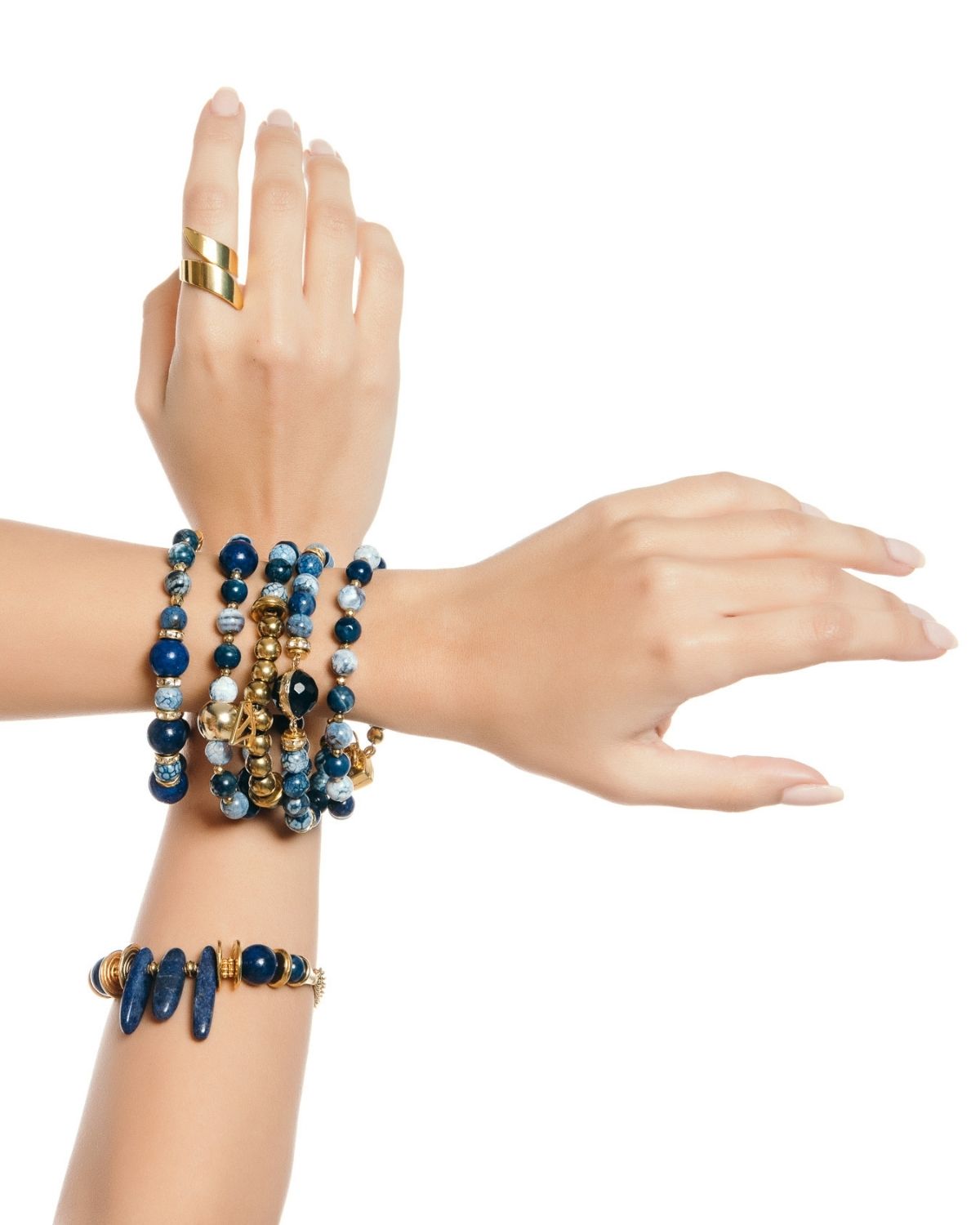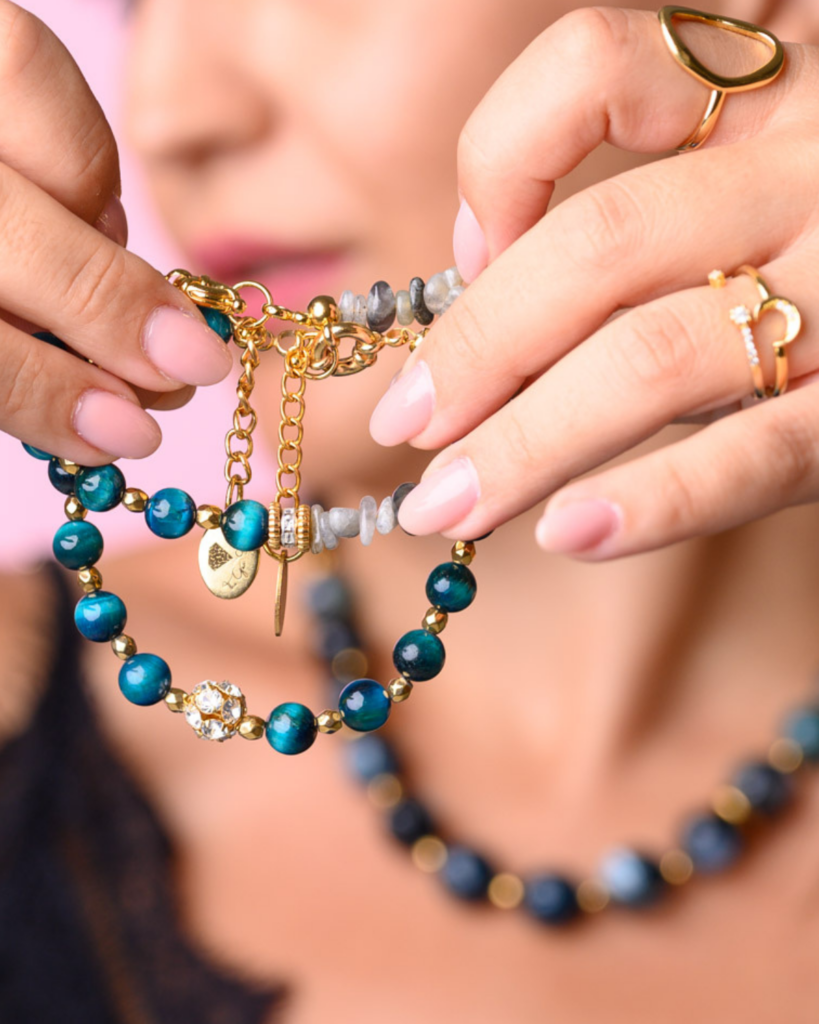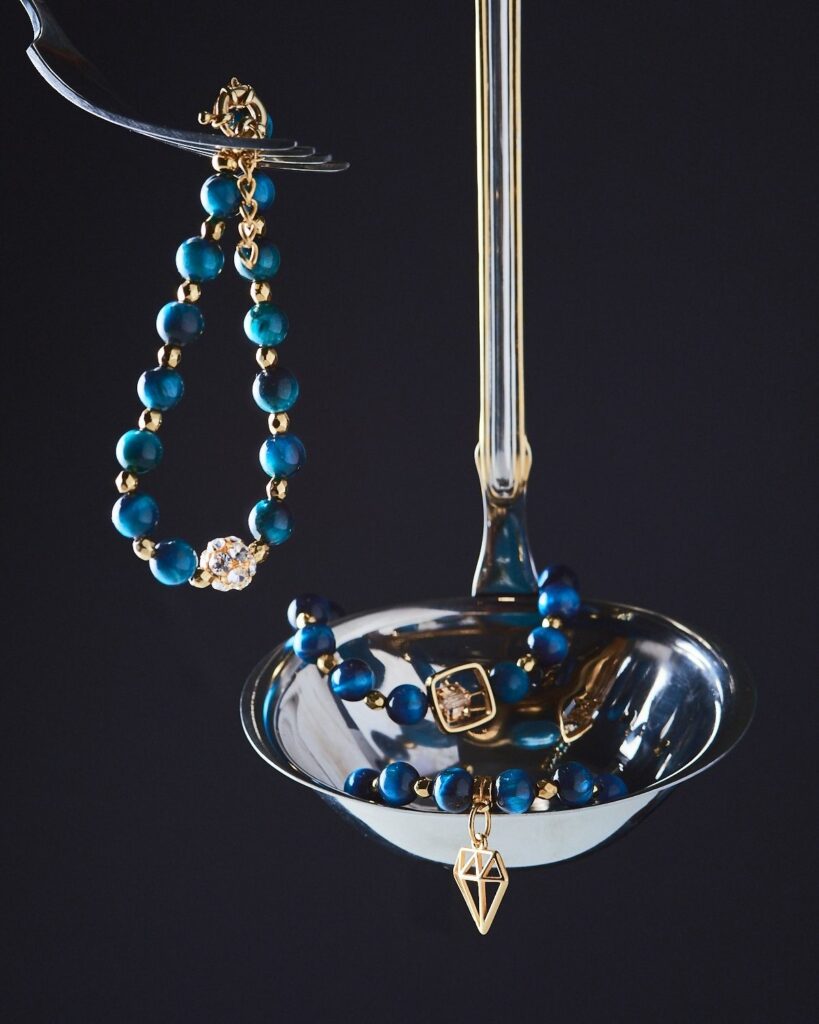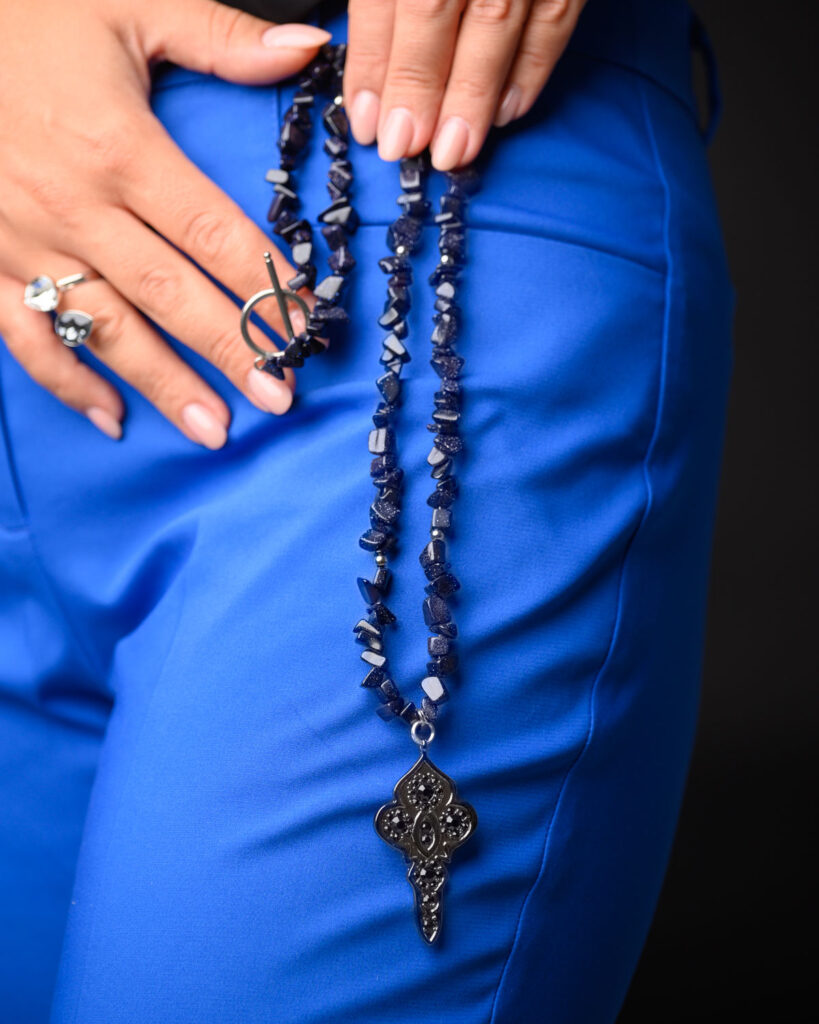- JEWELRY
BY CATEGORY
SEASONAL
BY MATERIAL/COLOR
- COLLECTIONS

awaken your joy
Shop now
Miyuki Elegance
Shop now - PERSONALIZED JEWELRY
- GIFTS

FOR HER
Shop now
FOR HIM
Shop now - TRENDING
- DISCOVER

aquamarine

emerald

amethyst

lapis lazuli

moss agate

ruby
- About us
- GR
-
Euro (€) - EUR
- United States (US) dollar ($) - USD
- Swiss franc (CHF) - CHF
- Canadian dollar ($) - CAD
- Japanese yen (¥) - JPY
- Brazilian real (R$) - BRL
- Chinese yuan (¥) - CNY
- Indian rupee (₹) - INR
- Singapore dollar ($) - SGD
- Australian dollar ($) - AUD
- United Arab Emirates dirham (د.إ) - AED
- Saudi riyal (ر.س) - SAR
- Qatari riyal (ر.ق) - QAR
- Turkish lira (₺) - TRY
- Mexican peso ($) - MXN
- Pound sterling (£) - GBP
- Swedish krona (kr) - SEK
- South African rand (R) - ZAR
- Malaysian ringgit (RM) - MYR
- Indonesian rupiah (Rp) - IDR
- Hong Kong dollar ($) - HKD
- North Korean won (₩) - KPW
- South Korean won (₩) - KRW
Lapis lazuli Meaning
The lapis lazuli meaning is literally ‘blue stone’, with blue deriving from the Persian word lazhward and stone from the Latin word lapis. Lazuli is also the name of the area where this stone originated from. This stone is often referred to as lapis, rather than the full name of lapis lazuli. In this section you will learn the different aspects of the lapis lazuli meaning including the properties and powers of this rock. You will also gain an insight into how it was used in different cultures around the world.
Lapis Lazuli Definition
The lapis lazuli gemstone is an opaque, semi-precious stone made from metamorphic volcanic rock. It is composed of many minerals including glittering pyrite and milky calcite. The main mineral is lazurite, where the deep blue hue comes from. The result of this combination is a beautiful blue rock with glittering flecks of gold.
Lapis is mined all over the world, the most notable places are Pakistan, Chile, Russia, Colorado USA, Canada and Angola. It was originally found in Afghanistan and to this day, rocks sourced from this destination are still the most valuable. They were mined in Bactria, now known as Afghanistan. In 1271, Marco Polo described these wondrous lapis mines on his travels.
What is the spiritual meaning of lapis lazuli?
In the ancient world lapis lazuli has always been a favored stone. It has been discovered in tombs across Africa, Asia and Europe from prehistoric times. This reveals the powerful, spiritual meaning the lapis had for many cultures.
There is a legend about Inanna, the Sumerian goddess of love. Upon her descent into the underworld Inanna took seven symbols of her divine power. This included a lapis lazuli necklace made of beads and a lapis measuring rod. This reflects the views of lapis lazuli as a sacred stone. In ancient civilizations it was associated with religion and royalty and it was used as amulets and talismans by the Ancient Egyptians.
People of religion such as holy men, and even shamans, used this stone for many purposes. As mentioned above it was present inside tombs around the world and it was also thought of as an aphrodisiac by the Romans. The rich color and gold particles also had royal connotations and it was popularly used by royalty in the past.
In meditation this stone can cleanse you of negativity and instill a new energy which can help empower your thoughts. This stone can help to protect you against psychic and physical attacks. When meditating, either hold the stone or keep it close to you. Another great way to use it is when you are having a soothing bath. Lapis is a soft stone so make sure you do not submerge it, just keep it on the side of the bath without touching the water.
In the philosophy of feng shui, deep blue lapis can be used to protect the home while gold speckled lapis brings in good luck and fortune. Lapis lazuli is used to address health concerns when used properly, and for intellectual and business purposes. Using a bagua, place your lapis in the North for career progression, East for good health and South-East for abundance and wealth reasons. If you do not follow feng shui, just keep a blue lapis in a dominant room in your home to encourage positive energy.
Wearing lapis lazuli as close to the center of your throat as possible can help unblock your throat chakra. It can give you the power to voice your true thoughts that come from the heart. It offers confidence and allows you to clear up miscommunications.
Using a deep-hued lapis, you can also tap into the Anja chakra, also known as the third-eye chakra. This calming blue lapis is great for helping you collect your thoughts and calm the mind in order to become more intuitive and wise. If you are completely used to using stones for meditation then a great way to maximise the benefits is to lie down and align the lapis with your chakra points.
Blue lapis is often linked with the throat chakra, also known as the vishuddha chakra. This chakra is blue in color and offers the heart a voice. If this chakra is blocked then one cannot express their true selves clearly.
Discover your favorite jewelry
In today’s world, the lapis stone meaning can vary from beauty in the form of luxury jewelry to wisdom and healing if it is connected to the spiritual world. Lapis Lazuli properties include spiritual growth. The stone can be used in meditation to help you reach a higher level of spirituality.

Some say lapis has been around since 6000BCE and in ancient times, lapis lazuli uses included carvings, cosmetics and jewelry. In the past it was seen as a precious gem in Afghanistan and was used in trade in Europe and Africa.
Due to the deep blue color it was ground into a powder to be used for cosmetics and paintings. This powder is called ultramarine and Cleopatra was famous for using the blue tones as eyeshadow. For centuries ultramarine, in powder and oil form, has been used to create masterpieces. These pieces include the Girl with the Pearl Earring by Vermeer and Van Gogh’s Starry Night. When painting the frescoes on the magnificent ceiling of the Sistine Chapel in the Vatican, Michelangelo used this deep blue pigment.
While the lapis stone only scores 5-6 on the MOHS hardness rating, it can be used to create beautiful lapis jewelry. The deeper shaded stones are a popular choice for men’s jewelry and a striking collection of cufflinks can be found at Aspinal of London. Bottega Veneta offers a small selection of lapis lazuli earrings and Pascale Monvoisin sell a variety of lapis necklaces including this stunning lapis lazuli pendant. Lapis is used as a commemorative gift to celebrate the ninth wedding anniversary. It also has healing and metaphysical properties. It can do many things holistically, but we will get to that later in this section.
healing properties
What are the healing properties of lapis lazuli?
The lapis lazuli meaning is diverse and the stone has great healing and metaphysical properties. It is popularly used for holistic purposes around the world.
Metaphysical Properties
This beautiful stone resembles the evening sky speckled with golden stars, this is why the Ancient Greeks believed it symbolized the night sky. The Sumerians held the belief that to wear a lapis would be to carry around the spirit of Gods. With this in mind, lapis is seen to have powers to ward off evil and to offer strength, truth, courage and wisdom to anyone who bears the stone.
Lapis Lazuli Healing Properties
This stone is well known for increasing intellect and sharpening the mind. Using this stone will improve critical thinking which is why it is great for people who struggle to make decisions. Using a lapis stone will give you clarity while generating innovative ideas and allows the mind to open up to new things you would never have considered before.
Lapis gives you the wisdom needed to balance emotions. This stone can calm the nerves and help you process your internal feelings. By giving you the courage to face these feelings, this stone ultimately helps you understand why you feel the way you do. In turn, this helps you grow into a wiser and calmer person.
As this stone is connected to the throat chakra, it can help you speak your truth with ease and clarity. This is great in all aspects of your life, whether you’re experiencing issues in your relationship or you need to speak out at work. Voicing your thoughts, rather than internalising your feelings, can have a great effect on your mental wellbeing.
Due to the calming properties, the lapis gem can help alleviate insomnia. Using this stone on your body, or placing it close to you, while you sleep can help you get a good night’s rest. You may find that you are able to remember your dreams more easily too.
Lapis Lazuli Physical Healing Properties
As lapis is connected to the throat chakra it is naturally able to relieve the bearer of any problems related to the throat. Respiratory issues, sore throats and stiff necks can be alleviated by using the lapis gem. In addition, it can also help reduce dizziness and reduce headaches and PMS symptoms.



good quality lapis
The quality of a lapis stone depends on the four Cs—the color, cut, clarity and carat weight. The better the quality, the higher the price of the stone.
Color
Lapis, as you know, can vary from light blue-green hues to vibrant blue shades with a hint of violet. Amongst lapis enthusiasts it is generally agreed that the less white calcite present in the stone the higher the value. However, the amount of sparkling pyrite in the stone is up for discussion. If the stone is highly saturated with a rich blue color and sprinkled with attractive specks of glittery pyrite then value could be added for some dealers. Lapis stones that have an obvious green hue are the least expensive stones.
Cut
Traditionally, lapis have been cut for cabochons, carvings, beads and inlays. Nowadays it is often cut into free-form sculptures so that the natural beauty of the stone can be enjoyed.
Clarity
Due to the wide mix of minerals that are present in this rock, lapis can look cloudy with streaks of white and green. It can also appear totally smooth with only a blue color dominating the surface. The highest quality stone is blue lapis lazuli with no streaks of calcite present and very little pyrite. The golden pyrite, if present, must appear in very small speckles and has to be distributed in a way that is pleasing to the eye.
Carat
Rough lapis is naturally found large and whole. This is why it had been used for decorative carvings in the past. Nowadays, it is popularly used for art and jewelry.
Different Types
Chilean Lapis
The Chilean type is the most inexpensive variety of lapis lazuli and has obvious calcite notes running throughout the stone. It is lighter in color than other types and has green hues.
Russian Lapis
Russian lapis is also known as Siberian lapis. This stone has specks of gold from the pyrite and is found with varying levels of blue. Russian lapis can contain some calcite minerals.
Persian Lapis
This type is also known as Afghan lapis. It is noted for the intensity of the medium to dark, blue hue. This type is often solid in color and has a slight violet tinge to it. There is no calcite present in this rock and very little pyrite.
more information
Synthetic, enhanced and fake lapis
Lapis Lazuli has been synthesized by Pierre Gilson from France and Carroll Chatham from the United States. The procedure used is popularly called the ‘Gibson process’. The results are very similar to raw lapis lazuli that is naturally sourced. Lapis is a stone that is often enhanced by staining, resin impregnation and waxing. However, using these methods to enhance a lapis often leads to a stone that will fade over time. Unfortunately, there are also completely fake lapis rocks on the market. They appear in the form of other stones that have been treated to resemble lapis. Although there are a few tests you can do at home, it can be difficult to tell which is the real deal if you are not a gem expert. That’s why it is important to buy your stones from a reputable gem dealer. Don’t be afraid to ask for a certificate for proof.
Is Lapis rarer than diamond?
Although lapis is not an expensive stone, the super fine ones are very rare. These fine stones can fetch up to $100 to $150 carats in price but anything above 20 carats is hard to find when it comes to these super fine stones. Diamonds are famously very valuable, and some colored diamonds are rare. However, it is arguable that super fine blue lapis lazuli is just as rare, if not more rare, than diamonds.
about lapis lazuli
As mentioned above, this powerful stone can be connected to the fifth chakra to help you communicate with ease. If you get stage fright but you’re in a situation where you need to stand up and speak to people then this is the stone for you. Wear a lapis close to the most central part of your neck or hold the stone in your hand when you’re speaking. Doing so will relieve you of your anxieties and give you the courage to speak with ease.
The lapis stone has protective properties and can ward off physical and psychic attacks. This stone can also be used to protect you from other people’s negative energies and empower you to make positive decisions. As a protection stone, lapis cleanses you of negative thoughts and emboldens you to tap into your wisdom and take positive steps in your life.
This powerful stone is known for its luck-acquiring qualities. Whether you need luck in your career, finances or even in love, keeping a lapis close to you can help give you fortune in many aspects of your life. As a symbol of good luck, wearing this stone can recycle negative energy into positive energy.
Lapis lazuli is a soft stone with a MOHS hardness rating of 5-6 which is why extra care needs to be taken with this rock. It is a striking, unusual stone which is why it is so popularly used in jewelry but it is best to keep this stone for special occasions. However, earrings, pendants and any jewelry which doesn’t come into heavy contact may still be worn daily.
To keep your stone in good condition it should be repolished periodically. To clean it just use soapy water and a soft-bristled brush and dry it with a soft cloth. Do not use salt water as it may damage your stone and stay clear of chemical solvents, ultrasonic cleaning methods and steaming. When storing lapis, keep it away from other stones and wrap it in soft fabric to keep it from getting scratched.
Crystals are great because of the power they are able to give us, but they also have the ability to retain negative or stale energy. That’s why it’s important to cleanse crystals before using them to ensure they are personal to you and only hold good energy.
As a soft stone, lapis lazuli should not be cleansed using water. Instead, try to cleanse them by laying them out in the sun or in the full moon. For both methods, ensure you turn the lapis over so that the whole stone is able to soak in the goodness of the light. After thirty minutes your stone will be cleansed.
Another popular way to cleanse your crystals is using other cleansing crystals. For example, selenite and amethyst are naturally cleansing crystals. If you have large slabs of these crystals then carefully place your lapis on top and let it cleanse for up to thirty minutes. Take care when placing your lapis on other stones in case of scratches. When cleansing your lapis stone, always remember to clear your mind of negativity and only think positive thoughts.
Birthstones originate from the Biblical book of Exodus, specifically ‘the breastplate of Aaron’ story. In this story twelve gemstones adorned the breastplate and these stones represented the twelve birthstones we have today.
Lapis Lazuli Birthstone
One of the gemstones on the breastplate was sapphire, however it is argued that in Biblical times the word sapphire meant blue stone. Therefore, it is likely the stone that was actually encrusted in the breastplate was lapis lazuli due to how highly prized it was in ancient times. If this is to be believed then lapis lazuli is in fact the birthstone for September.
Lapis lazuli can be worn by anyone to gain healing benefits from the stone but there are beneficial ways to wear blue lapis. For example, if you are wearing this stone as a bracelet or ring then people who are right handed should wear the stone on their right hand and vice versa. Another useful tip comes from astrologers, who advise against wearing this stone with gold. To gain maximum benefit, pair it with platinum or silver instead.
If you are using the lapis occasionally then the best day to choose is Saturday. The best time would be in the evening, especially if a waning moon is present in the night sky. If you do not wish to wear lapis as jewelry then keeping a tumbled stone in your pocket will suffice. In this way, it can be used as a touchstone for good luck. For financial luck, you may want to keep a stone in your wallet or purse. However, be mindful that this is a soft stone and so you should take care to not scratch or damage it.
Discover your favorite jewelry

Lapis Lazuli has an extensive history
Lapis lazuli is a mystical stone not only in appearance but also in the spiritual, metaphysical and healing properties it offers. With a long-existing history, lapis was used as a protection stone for good luck and symbolized strength and courage. Nowadays, this stone is great for meditation, especially when used for the throat chakra and the third-eye chakra as it can help unblock energy channels. Lapis comes in many colors due to the mineral compositions but all lapis lazuli stones look great when made into jewelry. Wear it as a beautiful piece of jewelry to clear your mind in order to make good decisions, and to help you speak your truth with confidence.



